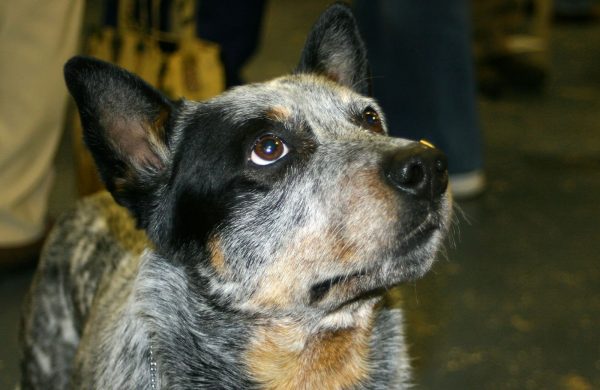“Puppy eyes” is a common expression referring to the look dogs give when they beg for one more dog treat or one more round of catch. Similar to humans, facial expressions in dogs (especially eye behavior) may be revealing their emotions.
Assertiveness can be detected in hard eye contact. When a dog is standing tall and still with a cold, hard stare, this usually means he is not feeling particularly friendly.
Friendliness is revealed in soft eye contact. If a dog shows soft, round eyes, he is often relaxed and approachable. Affiliative (distance decreasing) behavior such as a relaxed tail wag, and a curved or wiggling body can reinforce this interpretation.
What is commonly taken as a look of shame is more likely politeness. Avoiding eye contact by looking away from a person doesn’t necessarily mean the dog has something to hide. It is his way of showing politeness or deference, and an effort to not appear aggressive or confrontational.

A protective stance can be interpreted from the ‘side eye.’ When a dog shows the whites of its eyes by looking sideways while pointing its nose forward, it is often a sign of guarding. While keeping his nose pointed at the object it is trying to guard, this dog turns his eye on you to determine whether you are a threat.
Success
You are now signed up for our newsletter
Success
Check your email to complete sign up
The side-eye may not always indicate aggression, however, as it depends on the dog’s body language. If the rest of the body is relaxed, then the dog may just be giving you a once-over while maintaining interest in something else.
The ears and mouth are also important indicators of your dog’s state of mind. Understanding his or her body language will help you give your pet the best care possible.
A 2017 study from Scientific Reports demonstrates that dogs displayed more expressive facial expressions in the presence of humans than they did when no humans were around.
The researchers tested whether the dog’s response to food changed depending on the person’s attention through four scenarios:
- Paying attention to the dog when feeding it
- Paying attention to the dog but not giving it food
- Giving the dog food but not paying attention
- Not paying attention or eating
By analyzing the facial muscles of 24 dogs, the researchers found that subjects were more likely to show their tongues or raise their inner eyebrows when the human was facing them, and this was true with or without the visibility of food.
Contrary to what many expected, the dogs did not make the same faces when they were alone, whether they were eating or not. The study revealed that “dogs produced significantly more facial expressions when the human was oriented towards them, than when the human had her back turned to the dog.”

Juliane Kaminski, one of the authors of the study, stated: “I think this adds to a growing body of evidence that dogs are sensitive to our attention.” However, there is still no scientific evidence of whether these behaviors are intentional or indicate that they have an understanding of a human’s thoughts.
The authors conducted another study to determine whether humans actively select dogs that look younger due to their facial expressions when adopting.
It was determined that domestic dogs who frequently raise their inner brows were adopted more quickly. These movements make their eyes look larger and sadder, giving them the hard to resist ‘puppy eyes.’
However, while tail wagging and approaching the adopter indicate may friendliness, these factors did not correlate strongly with the speed of selection. Conversely, it was shown in the study that the longer the duration of tail wagging, the less chance of being selected.
The domesticated dog is a beast of great character and devotion. If he is, as we say, ‘man’s best friend,’ we would do well to understand and respond to, the ever-changing moods expressed in our pets’ faces; for as we can now see, their expressions may be expressly meant for us.













